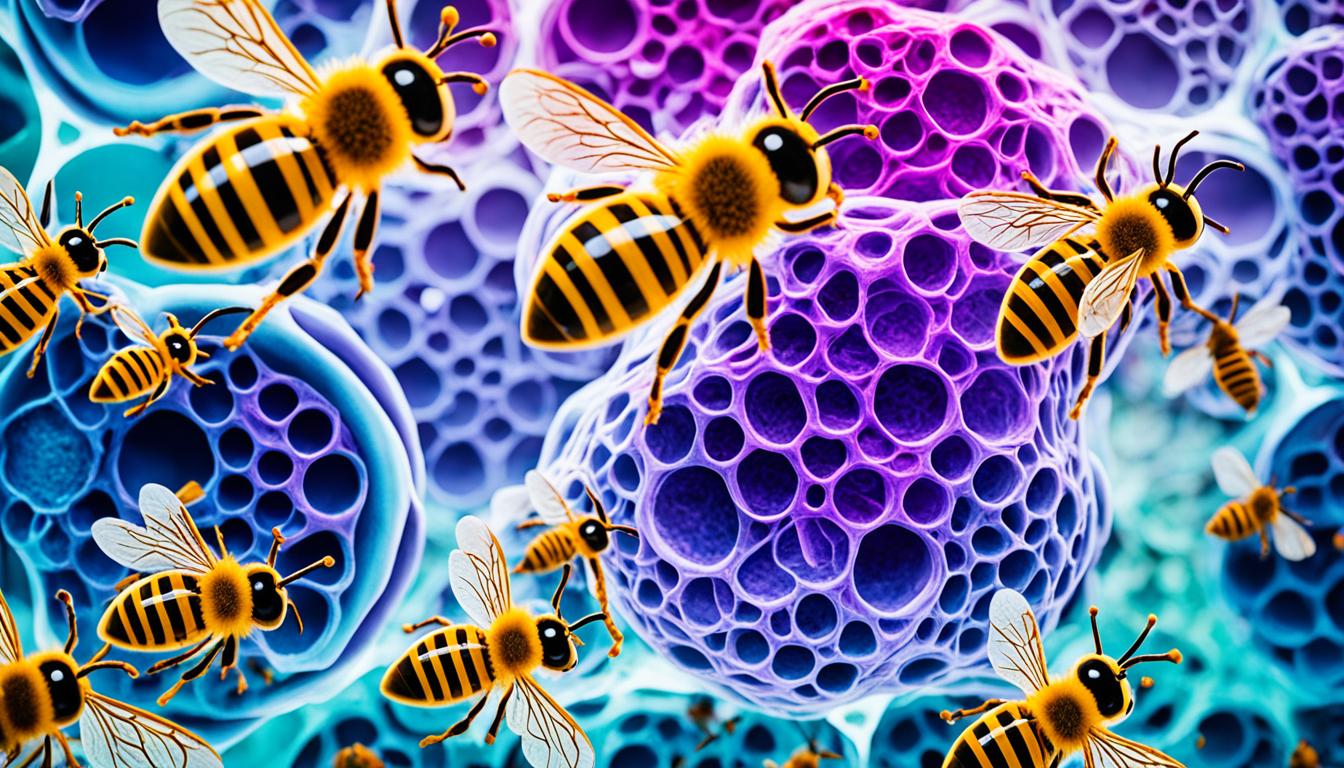Stings bee disease, known as bee sting allergy or bee venom allergy, happens when a bee sting causes a severe allergic reaction. Bee stings put venom into our bodies. This venom can set off our immune system, leading to many symptoms.
It’s important to know how to tell if a sting is from a bee or another insect. Honey bees, yellow bees, and bumblebees all have different venom. This difference can cause varied allergic reactions.
To diagnose stings bee disease, doctors look for specific symptoms and your bee exposure history. They pay close attention to the bee type, vital signs, and signs of anaphylaxis, a severe allergic reaction.
Medical research now looks at treatment like stem cell therapy for bee sting allergy. This therapy uses stem cells to heal damaged tissues and calm the immune system. There are positive results in using this therapy for bee sting allergy and other allergies.
Key Takeaways:
- Stings bee disease, or bee sting allergy, is an allergy that causes a severe reaction to bee stings.
- Bee stings inject venom into our bodies, unlike regular insect bites.
- By checking symptoms, the bee type, and vital signs, doctors can diagnose this condition.
- Stem cell therapy is a promising treatment for reducing symptoms of bee sting allergies.
- More studies are needed to discover the full benefit of stem cell therapy for bee sting allergies.
Diagnosis and Prevention of Bee Stings
Timely diagnosis and preventing bee stings are vital to keep people safe. It’s important to know the signs of a bee sting. This helps in providing the right medical help. Also, taking steps to prevent bee stings lowers the risk.
Diagnosing Bee Stings
Diagnosing a bee sting relies on its symptoms and a person’s bee contact history. Symptoms can be pain, redness, swelling, and itchiness. Some might even have severe reactions like trouble breathing or a life-threatening anaphylaxis.
Knowing the bee type is crucial. Different bees like honey bees or bumblebees have different venom. This affects the sting’s reaction. This bee information is key for doctors to plan treatment.
It’s also important to monitor health signs after a sting. For example, check heart rate and breathing. If anaphylaxis signs show, quick medical help is critical to stop severe issues.
Preventing Bee Stings
Preventing bee stings is crucial. Below are easy tips to cut the risk:
- Wear protective clothing outdoors like long sleeves and pants.
- Skip bright clothes or floral patterns that attract bees.
- Be careful with plants that attract bees.
- Don’t make sudden movements or loud noises near bees.
- If a bee is close, move away slowly without swatting it.
- Check gardens for bee nests often. Call experts to get rid of them.
By using these tips and being careful around bees, you can avoid stings.
| Signs and Symptoms of Bee Stings | Preventive Measures |
|---|---|
| Pain, redness, swelling, and itching at the sting site | Wear protective clothing |
| Severe allergic reactions, such as difficulty breathing and anaphylaxis | Avoid wearing bright colors or floral patterns |
| Vital signs monitoring | Be cautious around flowering plants |
| Identifying the type of bee involved | Avoid abrupt movements and loud noises |
Stem Cell Therapy for Bee Sting Allergy
Stem cell therapy is a new hope for people with bee sting allergy. These cells have special abilities that might ease symptoms and cut down on allergic reactions. This includes bee sting allergies.
Studies are showing good signs. Stem cells can fix the body from bee venom damage. They help with healing and make allergic reactions less severe. Plus, they can calm down the body’s overreaction to bee stings.
This treatment is new but looks promising. It might be a fresh start for those with severe bee sting allergies. More research and tests are being done. This will show how well it works and if it’s safe.
As we learn more about stem cell therapy, the outlook is positive. There’s hope that it can help improve the lives of those with bee sting allergy. With more progress and findings, relief may be closer than before.

